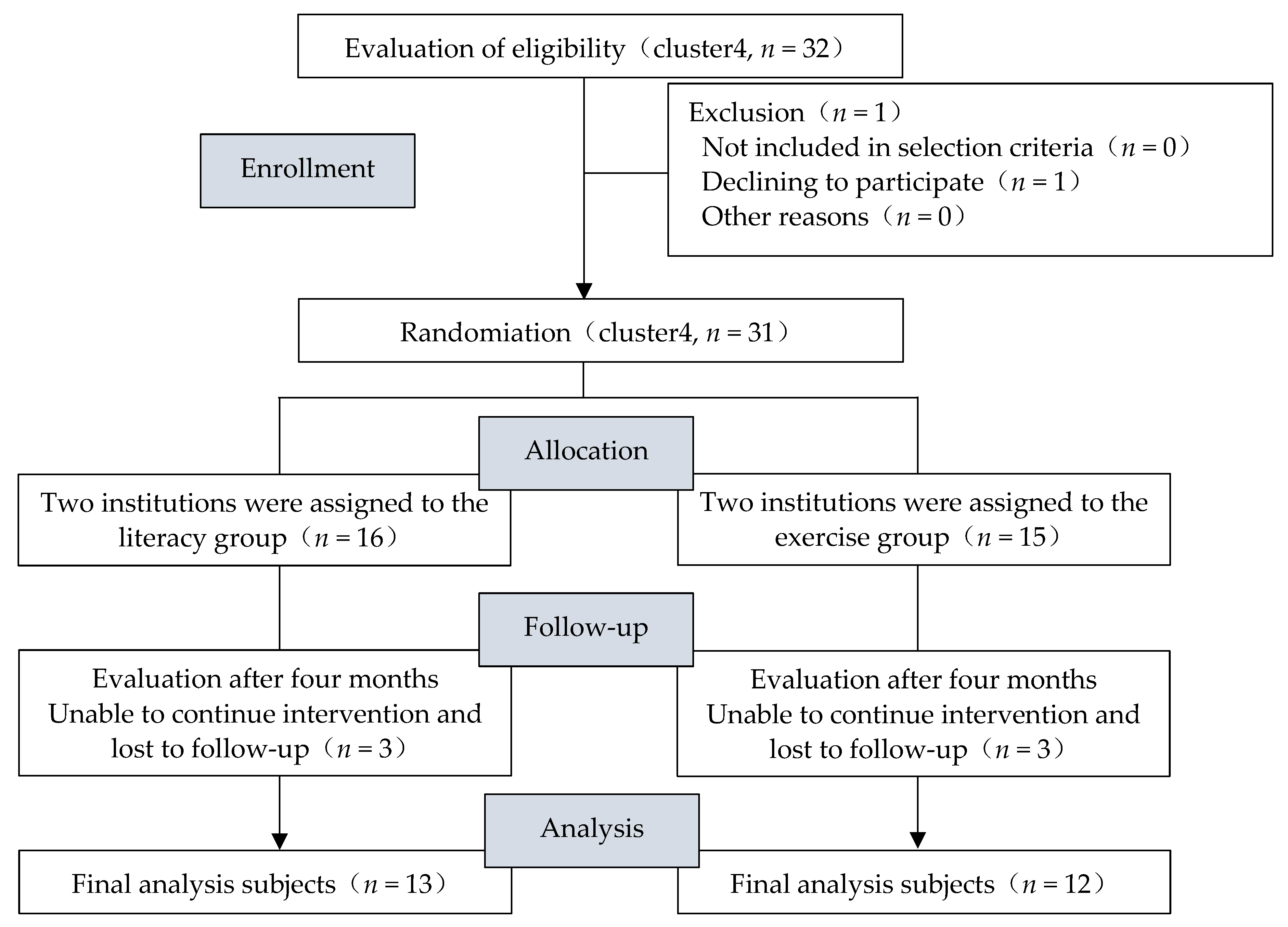A Pilot Study of a Group Program Focused on Enabling Life Performance for Older Adults Living in the Community
Abstract
:1. Introduction
2. Materials and Methods
2.1. Research Design
2.2. Study Subjects, Recruitment Method, and Period
2.3. Allocation and Blinding
2.4. Overview of the Program
2.4.1. A Framework of the Program
2.4.2. Literacy Group
2.4.3. Exercise Group
2.5. Measurements
2.5.1. Demographics
2.5.2. Outcomes
2.6. Sample Size
2.7. Statistical Analysis
2.8. Ethical Considerations
3. Results
3.1. Analysis Subjects and Follow-Up Rates
3.2. Demographics and the Average Number of Programs Attended
3.3. Comparison of Two Factors for Outcome Measures
4. Discussion
4.1. Program Feasibility
4.2. Effects of the Program
4.3. Limitations and Future Prospects
5. Conclusions
Author Contributions
Funding
Institutional Review Board Statement
Informed Consent Statement
Data Availability Statement
Acknowledgments
Conflicts of Interest
References
- Fried, L.P.; Tangen, C.M.; Walston, J.; Newman, A.B.; Hirsch, C.; Gottdiener, J.; Seeman, T.; Tracy, R.; Kop, W.J.; Burke, G.; et al. Cardiovascular Health Study Collaborative Research Group. Frailty in older adults: Evidence for a phenotype. J. Gerontol. Ser. A Biol. Sci. Med. Sci. 2001, 56, 146–156. [Google Scholar] [CrossRef] [PubMed]
- Satake, S.; Shimada, H.; Yamada, M.; Kim, H.; Yoshida, H.; Gondo, Y.; Matsubayashi, K.; Matsushita, E.; Kuzuya, M.; Kozaki, K.; et al. Prevalence of frailty among community-dwellers and outpatients in Japan as defined by the Japanese version of the Cardiovascular Health Study criteria. Geriatr. Gerontol. Int. 2017, 17, 2629–2634. [Google Scholar] [CrossRef] [PubMed]
- Yamada, M.; Arai, H. Social Frailty Predicts Incident Disability and Mortality Among Community-Dwelling Japanese Older Adults. J. Am. Med. Dir. Assoc. 2018, 19, 1099–1103. [Google Scholar] [CrossRef] [PubMed]
- Makizako, H.; Shimada, H.; Tsutsumimoto, K.; Lee, S.; Doi, T.; Nakakubo, S.; Hotta, R.; Suzuki, T. Social Frailty in Community-Dwelling Older Adults as a Risk Factor for Disability. J. Am. Med. Dir. Assoc. 2015, 16, 1003.e7–1003.e11. [Google Scholar] [CrossRef] [PubMed]
- Yoshimura, Y.; Wakabayashi, H.; Yamada, M.; Kim, H.; Harada, A.; Arai, H. Interventions for Treating Sarcopenia: A Systematic Review and Meta-Analysis of Randomized Controlled Studies. J. Am. Med. Dir. Assoc. 2017, 18, 553.e1–553.e16. [Google Scholar] [CrossRef] [PubMed]
- Hsieh, T.J.; Su, S.C.; Chen, C.W.; Kang, Y.W.; Hu, M.H.; Hsu, L.L.; Wu, S.Y.; Chen, L.; Chang, H.Y.; Chuang, S.Y.; et al. Individualized home-based exercise and nutrition interventions improve frailty in older adults: A randomized controlled trial. Int. J. Behav. Nutr. Phys. Act. 2019, 16, 119. [Google Scholar] [CrossRef] [PubMed] [Green Version]
- Jyväkorpi, S.K.; Ramel, A.; Strandberg, T.E.; Piotrowicz, K.; Błaszczyk-Bębenek, E.; Urtamo, A.; Rempe, H.M.; Geirsdóttir, Ó.; Vágnerová, T.; Billot, M.; et al. The sarcopenia and physical frailty in older people: Multi-component treatment strategies (SPRINTT) project: Description and feasibility of a nutrition intervention in community-dwelling older Europeans. Eur. Geriatr. Med. 2021, 12, 303–312. [Google Scholar] [CrossRef] [PubMed]
- Baker, P.S.; Bodner, E.V.; Allman, R.M. Measuring life-space mobility in community-dwelling older adults. J. Am. Geriatr. Soc. 2003, 51, 1610–1614. [Google Scholar] [CrossRef] [PubMed]
- Van Het Bolscher-Niehuis, M.J.; den Ouden, M.E.; de Vocht, H.M.; Francke, A.L. Effects of self-management support programmes on activities of daily living of older adults: A systematic review. Int. J. Nurs. Stud. 2016, 61, 230–247. [Google Scholar] [CrossRef] [PubMed] [Green Version]
- Yuri, Y.; Takabatake, S.; Nishikawa, T.; Oka, M.; Fujiwara, T. Erratum to: The effects of a life goal-setting technique in a preventive care program for frail community-dwelling older people: A cluster nonrandomized controlled trial. BMC Geriatr. 2017, 17, 104. [Google Scholar] [CrossRef] [PubMed]
- Kawamata, H.; Yamada, T.; Kobayashi, N. Effectiveness of an occupational therapy program for health promotion among healthy elderly. A randomized controlled trial. Jpn. J. Public Health 2012, 59, 73–81. [Google Scholar]
- Ishibashi, H.; Ishii, Y.; Ishibashi, Y. A preliminary study on developing a social participation support program that relates life and makeup. J. Jpn. Soc. Occup. Ther. Res. 2017, 20, 9–15. [Google Scholar]
- World Health Organization. The 1st International Conference on Health Promotion, Ottawa. 1986. Available online: https://www.who.int/teams/health-promotion/enhanced-wellbeing/first-global-conference (accessed on 14 March 2022).
- Fisher, A.G. Occupational Therapy Intervention Process Model: A Model for Planning and Implementing Top-Down, Client-Centered, and Occupation-Based Interventions; Three Star Press Inc.: Fort Collins, CO, USA, 2009; pp. 53–56. [Google Scholar]
- Albert, B. Psychology of Modeling Theory and Methods of Observational Learning; Kaneko Shobo: Tokyo, Japan, 1975; pp. 8–63. [Google Scholar]
- Ministry of Health, Labour and Welfare, Nursing Care Prevention Manual, Revised Edition. Available online: https://www.mhlw.go.jp/topics/2009/05/dl/tp0501-1_1.pdf (accessed on 10 February 2022).
- Harada, C. Goal Achievement Scaling (GAS). J. Occup. Ther. 2004, 38, 591–594. [Google Scholar]
- Takagi, M.; Nishida, S.; Kondo, T. Effects of visiting occupational therapy on older people with dementia and their family caregivers at home using COPM, AMPS, and GAS. Dement. Care Case J. 2012, 5, 93–102. [Google Scholar]
- Tasaki, M.; Nakane, M. WHOQOL26 Guide Revised Edition; Kaneko Shobo: Tokyo, Japan, 1997; pp. 5–13. [Google Scholar]
- Koyano, W.; Shibata, H.; Nakazato, K. Measurement of activity capacity in the elderly and development of the RERF-type activity capacity index. Jpn. J. Public Health 1987, 34, 109–114. [Google Scholar]
- Nakazato, K. Quality of life approach from psychology. Nurs. Res. 1992, 25, 193–202. [Google Scholar]
- Ministry of Education, Culture, Sports, Science, and Technology, Guidelines for the New Physical Fitness Test. Available online: http://www.mext.go.jp/component/a_menu/sports/detail/__icsFiles/afieldfile/2010/07/30/1295079_04.pdf (accessed on 10 February 2022).
- Annals of Internal Medicine, ACP Journal Club Inclusion Criteria. Available online: http://annals.org/aim/pages/acpjc-inclusion-criteria (accessed on 10 February 2022).
- Kishita, R.; Nagaki, K.; Ishizuki, C.; Miyaguchi, H. The relationship between subjective well-being, activity participation status, and basic attributes in community-dwelling older adults. Acad. J. Occup. Ther. 2021, 40, 34–41. [Google Scholar] [CrossRef]
- Berger, S.; Escher, A.; Mengle, E.; Sullivan, N. Effectiveness of Health Promotion, Management, and Maintenance Interventions Within the Scope of Occupational Therapy for Community-Dwelling Older Adults: A Systematic Review. Am. J. Occup. Ther. Off. Publ. Am. Occup. Ther. Assoc. 2018, 72, 7204190010p1–7204190010p10. [Google Scholar] [CrossRef] [PubMed]
- Zhuang, J.; Huang, L.; Wu, Y.; Zhang, Y. The effectiveness of a combined exercise intervention on physical fitness factors related to falls in community-dwelling older adults. Clin. Interv. Aging 2014, 9, 131–140. [Google Scholar] [CrossRef] [PubMed] [Green Version]
- Bouaziz, W.; Lang, P.O.; Schmitt, E.; Kaltenbach, G.; Geny, B.; Vogel, T. Health benefits of multicomponent training programmes in seniors: A systematic review. Int. J. Clin. Pract. 2016, 70, 520–536. [Google Scholar] [CrossRef] [PubMed]


| Literacy Group | Exercise Group | ||
|---|---|---|---|
| No. | The Theme of the Lecture | Group Work | Contents |
| Part 1 | Program implementation, schedule confirmation, initial evaluation | ||
| Part 2 | Quality of life | Video on life performance and discussion on problem-solving | Exercises to prevent knee pain |
| Part 3 | Life and Health | Discussion of learning topics | Exercise to prevent back pain |
| Part 4 | Organization of space and objects | Video on life performance and discussion on problem-solving | Exercise to prevent falling over |
| Part 5 | Review of progress on life goals and group work | Review of progress on life goals and group work, Exercises to prevent knee pain | |
| Part 6 | Adaptation of temporal organization and performance | Video on life performance and discussion on problem-solving | Exercise to prevent back pain |
| Part 7 | Occupational analysis | Exercise to prevent falling over | |
| Part 8 | Completion Ceremony, Final Evaluation | ||
| Literacy Group (n = 13) | Exercise Group (n = 12) | |
|---|---|---|
| Age (mean ± SD) | 75.8 ± 4.76 | 76.5 ± 5.5 |
| 65–69 | 1 | 2 |
| 70–74 | 5 | 2 |
| 75–79 | 5 | 5 |
| 80–85 | 2 | 3 |
| Gender | ||
| Male | 3 | 2 |
| Female | 10 | 10 |
| Certified as requiring long-term care | ||
| Support | 3 | 0 |
| Not applicable | 10 | 12 |
| Presence of disease (yes) | 7 | 7 |
| Presence of habits (yes) | 8 | 8 |
| Family living together (yes) | 8 | 10 |
| Frequency of going out (yes) | 13 | 12 |
| Literacy n = 13 | Exercise n = 12 | p-Value | ||||||
|---|---|---|---|---|---|---|---|---|
| Baseline 1 | Post Intervention 1 | Baseline 1 | Post Intervention 1 | Time | Group | Time × Group | ||
| TMIG-IC | Total | 12.0 (1.6) | 12.0 (1.4) | 12.3 (1.2) | 12.4 (0.9) | 0.98 | 0.52 | 0.54 |
| Instrumental | 4.9 (0.2) | 5.0 (0) | 4.9 (0.2) | 4.8 (0.3) | 0.95 | 0.37 | 0.17 | |
| Active | 3.6 (0.8) | 3.7 (0.5) | 3.8 (0.3) | 3.9 (0.2) | 0.28 | 0.39 | 0.74 | |
| Social | 3.5 (0.9) | 3.2 (1.1) | 3.5 (0.9) | 3.6 (0.6) | 0.50 | 0.48 | 0.24 | |
| LSI-Z | Total | 8.4 (3.2) | 8.6 (3.5) | 8.5 (2.5) | 9.5 (2.1) | 0.03 * | 0.69 | 0.11 |
| WHOQOL26 | Physical | 23.1 (4.4) | 23.1 (4.6) | 26.4 (4.2) | 26.1 (4.6) | 0.84 | 0.07 | 0.84 |
| Psychological | 19.9 (4.5) | 19.3 (5.0) | 21.4 (5.1) | 22.5 (3.3) | 0.66 | 0.19 | 0.12 | |
| Social | 9.3 (1.8) | 9.8 (1.6) | 11.0 (2.0) | 11.2 (2.0) | 0.19 | 0.04 * | 0.69 | |
| Environmental | 25.5 (5.8) | 26.6 (5.8) | 30.9 (4.5) | 30.9 (5.0) | 0.39 | 0.02 * | 0.39 | |
| GAS-L | Crude score | −1.0 (0) | 0.3 (0.8) | −1.0 (0) | −0.1 (0.9) | 0.01 ** | 0.19 | 0.19 |
| Physical fitness tests | Grip strength | 22.0 (5.5) | 22.3 (6.4) | 22.2 (6.0) | 22.3 (6.0) | 0.60 | 0.95 | 0.82 |
| Maximum 5 m | 4.6 (2.3) | 3.9 (1.4) | 2.9 (1.1) | 2.6 (0.7) | 0.01 ** | 0.02 * | 0.23 | |
| TUG | 9.8 (4.0) | 8.9 (3.1) | 7.5 (2.4) | 6.0 (1.6) | 0.01 ** | 0.03 * | 0.20 | |
Publisher’s Note: MDPI stays neutral with regard to jurisdictional claims in published maps and institutional affiliations. |
© 2022 by the authors. Licensee MDPI, Basel, Switzerland. This article is an open access article distributed under the terms and conditions of the Creative Commons Attribution (CC BY) license (https://creativecommons.org/licenses/by/4.0/).
Share and Cite
Furuta, K.; Kobayashi, N.; Kobayashi, R.; Ishibashi, H.; Ishibashi, Y. A Pilot Study of a Group Program Focused on Enabling Life Performance for Older Adults Living in the Community. Int. J. Environ. Res. Public Health 2022, 19, 3761. https://doi.org/10.3390/ijerph19073761
Furuta K, Kobayashi N, Kobayashi R, Ishibashi H, Ishibashi Y. A Pilot Study of a Group Program Focused on Enabling Life Performance for Older Adults Living in the Community. International Journal of Environmental Research and Public Health. 2022; 19(7):3761. https://doi.org/10.3390/ijerph19073761
Chicago/Turabian StyleFuruta, Kenichiro, Norikazu Kobayashi, Ryuji Kobayashi, Hitomi Ishibashi, and Yu Ishibashi. 2022. "A Pilot Study of a Group Program Focused on Enabling Life Performance for Older Adults Living in the Community" International Journal of Environmental Research and Public Health 19, no. 7: 3761. https://doi.org/10.3390/ijerph19073761
APA StyleFuruta, K., Kobayashi, N., Kobayashi, R., Ishibashi, H., & Ishibashi, Y. (2022). A Pilot Study of a Group Program Focused on Enabling Life Performance for Older Adults Living in the Community. International Journal of Environmental Research and Public Health, 19(7), 3761. https://doi.org/10.3390/ijerph19073761






